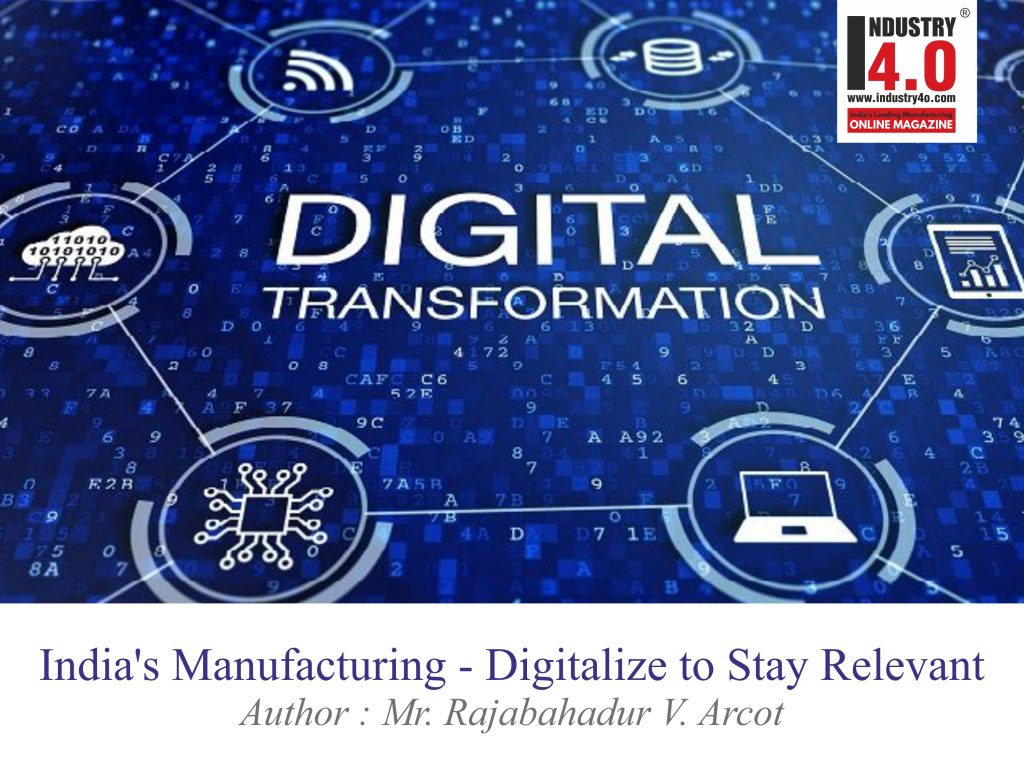Industry 4.0 implementation roadmap, fourth industrial revolution, digitization, digitalization, and such others are the buzzwords that one often hears when captains of the industry meet. Numerous reports relating to those terms also appear in the media very frequently. These terms, often used interchangeably, describe how the tremendous developments taking place in computers, computer networks, information technology and its convergence with communication technology will transform the manufacturing. The transformation will come about as the technological developments have the potential to empower manufacturing to comprehensively monitor assets & processes and make that information available to all the stake-holders in the value creation networks and thereby make the decision making process autonomous and efficient. The digital technologies typically associated with the vision of Industry 4.0 include Industrial Internet of Things (IIoT), Edge Computing, Cloud Computing, Big Data and Analytics, Artificial Intelligence (AI), Machine Learning, Autonomous Robots, and such others. While the terms Industry 4.0 and fourth industrial revolution have been coined by looking at the transformation from historical viewpoint, digitization & digitalization define the process of transformation from technical perspective.
These digital technologies have evolved over the past several years. The arrival of transistors around the year 1950 triggered not only rapid developments in industrial electronics and entry of computers, initially as mainframe and subsequently as mini & personal computers, microprocessors, and such others but also the convergence with communication technologies. These developments led to the entry of solid state relays & controllers, programmable logic controllers, distributed control systems, and such other industrial automation systems. Expanding use of electronics and computers spurred further developments that contributed to decline in prices, miniaturization & robustness of computers, and massive increase in their computing and processing power. These developments not only contributed to the growth of digital technologies but also expanded the application possibilities in production processes. While these developments heralded the start of the third industrial revolution, the use of water and steam equipment to help humans in performing some of their tasks and use of electricity and the application respectively heralded the start of the first and second industrial revolutions.
In the years to come, as the fourth industrial revolution evolves, industrial firms have the option to leverage digital technologies, which will help them to achieve operational excellence through productivity improvements, efficient deployment of all resources including material & human, customer fulfillment, and enhancing shareholder value.
Even as of now, industrial firms depend on computer technology to manage their operations and they will continue to do so in future too. They use industrial control systems, such as distributed control systems (DC) and programmable logic controllers (PLC) to manage their shop floor operations, enterprise resource planning solutions at the corporate level, and solutions such as the supply chain management, supplier relationship management, and customer relationship to manage operations along the value chain. Some also deploy product lifecycle management solution to the handle the development and introduction, growth, maturity, and retirement of their products. However, they have some challenges in the use of IIoT and such other digital technologies, especially in their industrial control systems. They expect a high degree of availability, repeatability, and reliability from their industrial control systems such as DCS & PLC and the digital technology based systems are yet to establish that they meet these criteria.
Digital technologies associated with Industry 4.0 are deployable-ready otherwise, even though they are yet to establish proof of concept in the minds of industrial sector. There are numerous application-areas in industries, which can benefit for the inherent capabilities, such as connectivity and analytical capabilities that digital technologies bring to the table. Manufacturing companies, which want to leverage those capabilities, have to get started with the journey so that they can reap the benefits.
Deployment of these technologies will involve integration of physical systems with cyber systems so that they become vested with data & information processing, intelligence, and internet connectivity capabilities. The process of conversion will involve embedding digital technology components along with sensors and actuating devices in plant equipment, machinery and others in the value chains. Resulting from the intersection of physical and cyber will transform manufacturing and usher the fourth industrial revolution.
The idea of cyber-physical systems is the key to implementing Industry 4.0 concepts. Physical systems, such as pumpsetc., embedded with cyber and control components, such as sensors and actuators and internet enabled, become cyber-physical systems (CPS); they are capable of self-monitoring & autonomous operation. A company that wants to align its vision with that of industry 4.0 must take steps to digitalize existing physical entities into cyber-physical systems so that machines/plant equipment, logistics systems, and work-in-progress components and such others, including people, directly communicate and collaborate with each other.
Each manufacturing entity has to chart out its own roadmap driven by its objectives and their priorities to achieve the tenets of Industry 4.0. What is important is to get started. The way forward for a company is to begin the journey by identifying existing physical assets, whose improved performance can contribute significantly to enhancing its profitability & performance. Next, it has to decide on the additional monitoring & analysis required for achieving the objective; proceed accordingly to convert the identified physical assets into cyber-physical systems for gathering the information required; and initiate the implementation process. It has to set achievable milestones with each milestone having a specific objective, pursue them, evaluate the achievements, make course corrections as the journey continues, and set new objectives and pursue them.
Process plants, for example, have numerous auxiliaries, such as air compressors and many pumps & automatically controlled valves that typically are periodically inspected and maintained involving downtime and loss of revenue. The owner operators of these plants can convert some of the plant auxiliaries into cyber physical systems so that they generate the information required for adopting the predictive maintenance practices instead of preventive maintenance methodologies. Industrial wireless and IIoT technologies help generate large amount of data from the converted cyber-physical assets and cost effectively process them at the edge or on the cloud. They have to identify applications that will help them to improve their operations and discuss with a good system integrator with OT and IT skills to evolve the system that leverages the power of digital technologies that are already available.
About the Author

Mr. Rajabahadur V. Arcot
Independent Industry Analyst, Columnist and Automation Consultant.
Life Member of ISA.
Member of ISA Smart manufacturing & IIoT Division.
ISA accredited mentor and trainer.
He authors industry & technology articles, market research reports, case studies, white papers, automation & manufacturing IT insights.
He can be reached @ 98452 09442 / [email protected]
Also read my earlier article











